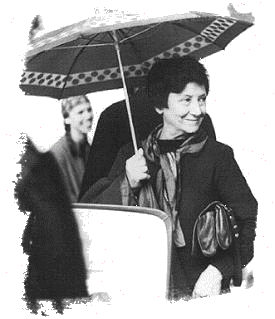
Thea Maass
Der Lebensweg von Thea Maass (14.07.1908 – 02.03.1989) war seit früher Kindheit eng mit dem Tanz verbunden. Prägend für ihre späteren künstlerischen Leistungen als Choreografin und Tanzpädagogin war das Studium bei Mary Wigman. An deren Schule erhielt sie nicht nur eine hervorragende tanztechnische Ausbildung, sondern wurde auch durch tänzerische Improvisationen zu kreativem Schaffen angeregt.
Nach ihrer beruflichen Laufbahn als Tänzerin, Ballettmeisterin und Choreografin an verschiedenen Theatern Deutschlands übernahm sie 1953 gemeinsam mit Aenne Goldschmidt den Aufbau der Tanzgruppe im Staatlichen Volkskunstensemble der DDR (später Tanzensemble der DDR). Thea Maass erkannte den unverzichtbaren Wert der Bewahrung und Wiedergewinnung der humanistischen Traditionen der deutschen Folklore. In der anregenden Zusammenarbeit mit Aenne Goldschmidt, ihrer Wegbereiterin und schöpferischen Mitstreiterin bis zuletzt, studierte sie jahrelang die Formen des deutschen Volkstanzes.
Sie schuf lebensvolle, realistische Folklorechoreografien, die inzwischen zu „Klassikern“ der Bühnenfolklore gehören, wie z.B. die Pfälzer Suite „Wenn im Herbst die Trauben reifen“ oder die bayerische Suite „Wenn der Auerhahn balzt“. Thea Maass leistete im Bemühen um künstlerische Wahrhaftigkeit im Tanz – verbunden mit einer unverwechselbaren Interpretation durch die Tänzer – einen unschätzbaren Beitrag zur Entwicklung des folkloristischen Bühnentanzes. Ihr Werk lebt fort im lebendigen Gedächtnis der Tänzerinnen und Tänzer des Folkloretanzensembles der TU Dresden, die aus der jahrzehntelangen schöpferischen Zusammenarbeit mit ihr eine tiefe menschliche und künstlerische Bereicherung erfuhren. Es lebt fort in der Bewahrung ihres realistischen Interpretationsstils und der sorgsamen Pflege ihrer außergewöhnlichen Tanzgestaltung.
In Würdigung ihres Lebenswerkes gab sich das Folkloretanzensemble der TU Dresden 1990 den Namen „Thea Maass”.
